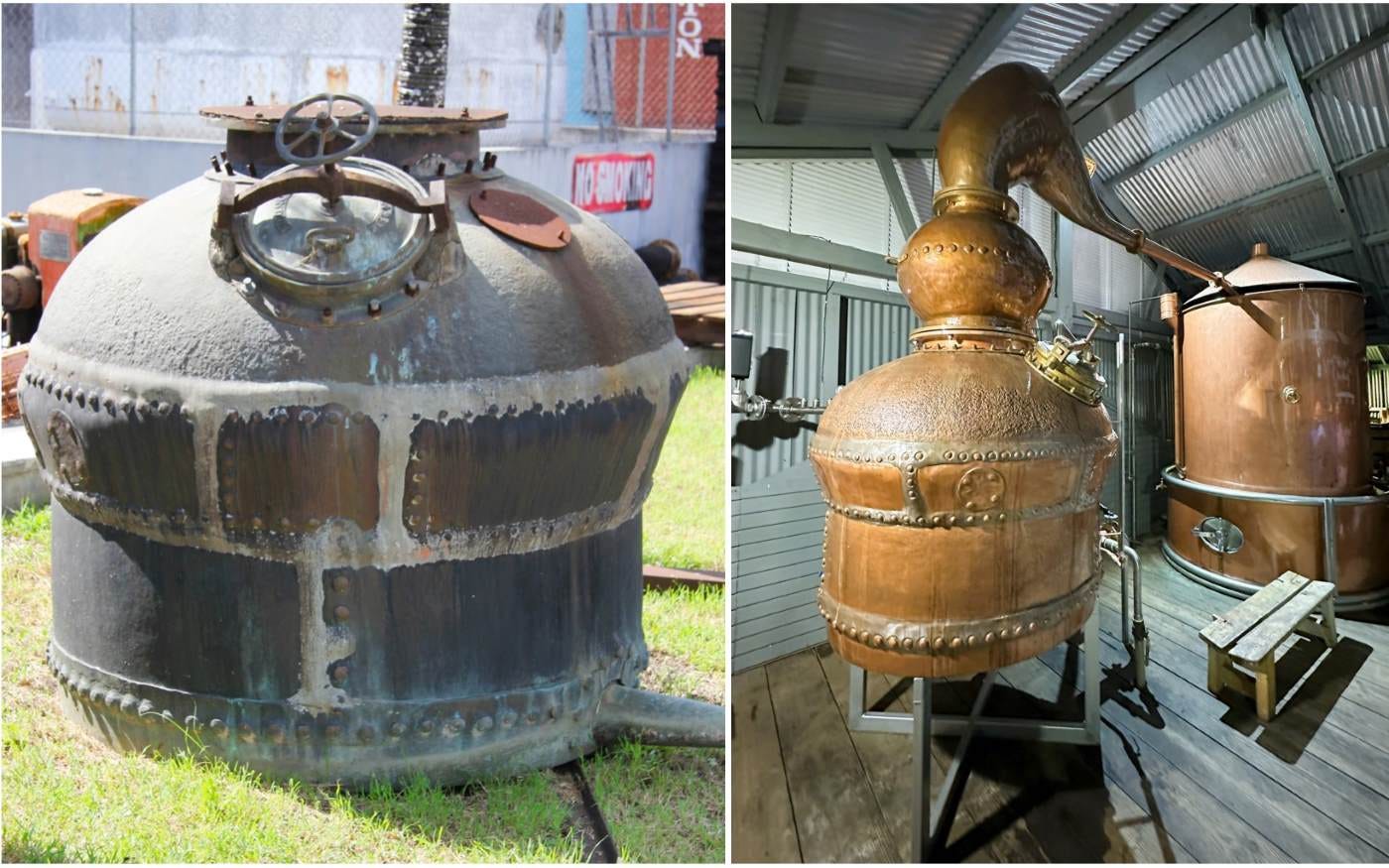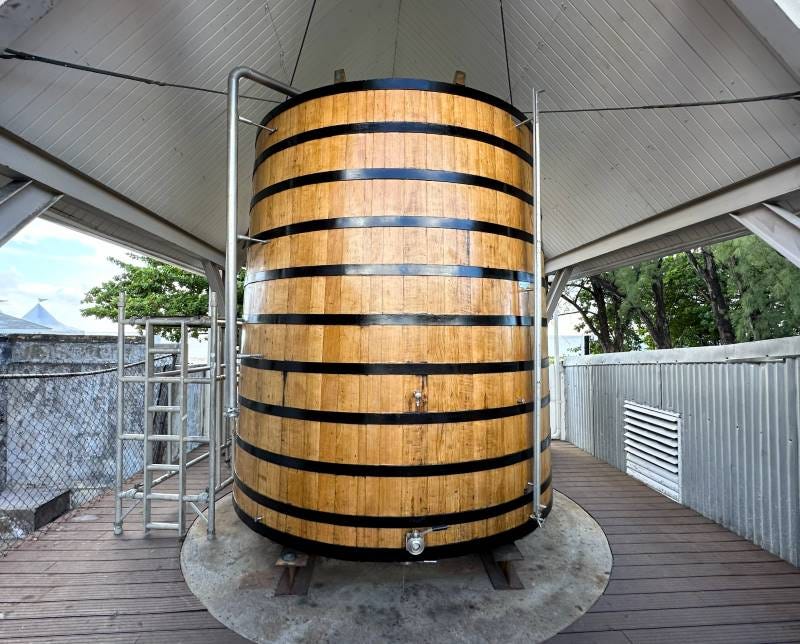A Revamped Rockley Still and Other WIRD News
After a multi-year absence from the Caribbean, it was great to return to Barbados for the 130th Anniversary celebration of the West Indies Rum Distillery (WIRD.) Master Distiller Benn, Managing Director Andrew Hassel, and owner Alexandre Gabriel gave speeches, and the celebration continued long after Mrs. Wonk and I called it an evening. During our short visit, I learned about many recent improvements and changes to the distillery.
The refurbished Rockley pot still’s public unveiling generated the most excitement among the assembled rum geeks. The Rockley is said to have been built around 1780, with modifications made in the 1800s. The Rockley’s kettle was relegated to a lawn near a distillery entrance for years. Where the neck went is anybody’s guess. See the photo above for a before/after glimpse.
Given his passion for distilling history, it’s no surprise that Alexandre Gabriel undertook to return the Rockley to service. He shipped it to France, where it underwent a lengthy restoration by the same coppersmiths who work on Gabriel’s cognac stills. The restoration included creating a new neck to replace the original neck. Using pot stills drawings from the 1700s, Gabriel designed a neck best described as an elephant trunk. The revamped Rockley arrived in Barbados shortly before the 130th anniversary celebration. But where to put it in a distillery already jam-packed with fermenters and stills?
The solution was to extend an existing elevated platform further towards the ocean. Dubbed “Pot Still Alley,” the enlarged platform provides access to WIRD’s four batch stills: the Gregg’s Farm, Hot Pot, Vulcan, and Rockley. The Gregg’s Farm was moved from ground level to the platform and resides a few meters from the newly installed Rockley. When the Rockley starts distilling — very soon, I’m told — WIRD will have four operational batch stills, the same as Mount Gay. Not bad for a distillery that until recently was known primarily for its light-column rum.
To commemorate the distillery’s birthday, the blending team created a limited-edition bottling of rums from several of WIRD’s vintage stills, including the Gregg’s Farm pot still. Full-sized bottles were displayed, and event attendees received 100 ml sample bottles in their gift bags. No word yet on where it will be sold, but the visitor’s center is a safe bet.
Attendees started their event visit traversing a maze of casks stacked six pallets high. Tasting stations within the maze showcased unusual WIRD-distilled rums, including a cane juice rum and a high ester rum clocking in at 1,500 gr/hlAA. The sheer size of the maze highlighted how many casks are aging at WIRD – over 35,000 and growing every year, according to a distillery representative.
Rum geeks who never pass on a distillery visit will be glad to learn that WIRD will soon have public tours. These tours will start at the newly revamped beach club/visitor’s center that adjoins the distillery. The original beach club was built by Malibu Rum, WIRD’s largest customer at the time. The club later operated as the Cockspur Beach Club for several years until it closed. When Plantation Rum purchased WIRD in 2017, the beach club was part of the purchase.
Here’s a short video on my Rum Wonk YouTube channel with scenes from my visit, including Pot Still Alley.
For those unfamiliar with WIRD’s history, I’ve included a brief synopsis below, excerpted and adapted from the Barbados chapter of Modern Caribbean Rum.
West Indies Rum Distillery Background
Built in 1893 by George Stade, a German engineer specializing in sugar processing and distillation equipment, the West India Rum Refinery (WIRR) introduced column distillation to Barbados. In 1994, WIRR was renamed the West Indies Rum Distillery (WIRD.) From its inception, WIRR/WIRD has distilled more rum each year than all the other Barbados distilleries combined. Currently, WIRD makes around 85% of the rum distilled in Barbados.
Located on the beach a few kilometers north of Bridgetown, WIRR was built as a standalone rum distillery rather than as part of a sugar estate. With WIRR, Stade showcased the latest distillation techniques for making rum at a lower price than small estate distilleries could produce. WIRR wasn’t established to sell rum for its own brand. Rather, it supplied rum to Barbados blenders for their private label brands. In time, rum made at WIRR became known as Stades rum.
WIRR became a publicly traded company in 1901, and many of its shareholders were also its customers, making WIRR a communal resource of sorts. Early WIRR shareholders included Valdemar Hanschell; Alleyne, Arthur & Co.; and Martin Doorly, all renowned names in Barbados rum of the era. Mount Gay and RL Seale have also purchased rum from WIRD over the years.
In October 1992, WIRD began distilling light rum for Malibu, a coconut-flavored liqueur. In time, Malibu became WIRD’s largest customer and remained so for many years.
Maison Ferrand/Plantation Rum purchased WIRD in 2017 and immediately undertook many distillery upgrades, including:
New and recommissioned batch stills and many new open-air fermentation vats
A new vacuum column to make heavy rum for the Plantation brand
Building the Harper sugarcane mill to supply cane juice to the distillery
Creating a “nursery” to cultivate large quantities of natural yeast
Open-air maturation vats (“Beach vat”)
The Stades brand, produced entirely at WIRD, debuted in 2021.
Disclosure: I attended the 130th Anniversary event as a guest of Plantation Rum, who arranged for my travel.











I just saw Stade’s listed for sale at my local TW. It wouldn’t have been on my radar if I hadn’t read this!
Great article! Thanks again for letting me feel like I'm traveling there too!
Question: you mentioned a very high ester rum. Did WIRD make it? If so, do they have a muck pit?